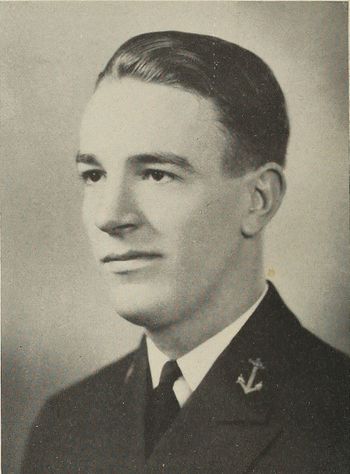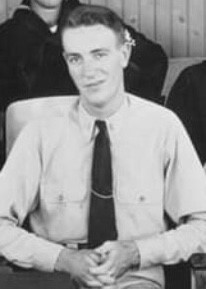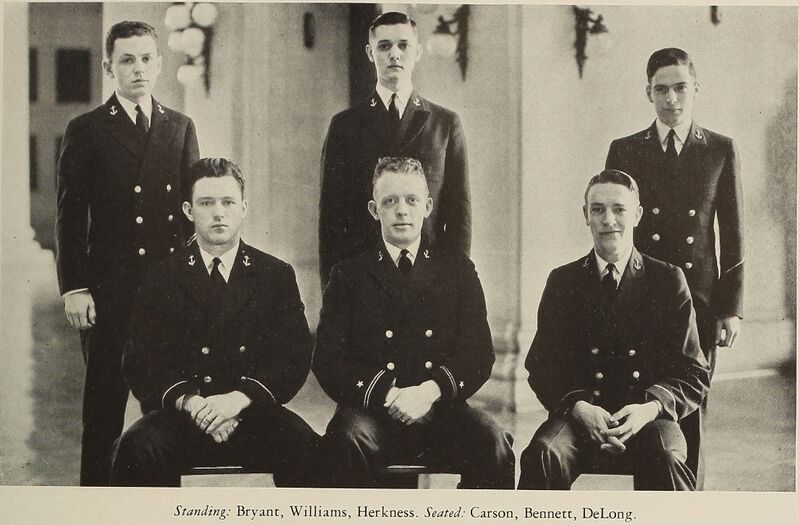EDWARD G. DELONG, LT, USN
Edward DeLong '37
Lucky Bag
From the 1937 Lucky Bag:
EDWARD GROVER DE LONG
Springfield, South Dakota
"Grover" "Ed" "Champ" "Dee"
FATE had its way, and a third alternate appointment took Grover from a co-ed college and made him one of '37. Endowed with an admirable ability of meeting people, especially the fairer sex, he carries on a voluminous correspondence. During study hour, Ed is usually seen with pipe in one hand, pen in the other, and photographic likenesses before him. Music is his weakness, be it via the radio, choir, musical clubs, or French horn. He is often at home with a Sabatini novel or an engineering magazine. Versatility and steadiness have made him a splendid roommate and friend.
Track 4, 2, 1. Basketball 3, 1. Orchestra 4, 3, 2, 1. Choir. Musical Clubs Shows. Reception Committee. One Stripe.

EDWARD GROVER DE LONG
Springfield, South Dakota
"Grover" "Ed" "Champ" "Dee"
FATE had its way, and a third alternate appointment took Grover from a co-ed college and made him one of '37. Endowed with an admirable ability of meeting people, especially the fairer sex, he carries on a voluminous correspondence. During study hour, Ed is usually seen with pipe in one hand, pen in the other, and photographic likenesses before him. Music is his weakness, be it via the radio, choir, musical clubs, or French horn. He is often at home with a Sabatini novel or an engineering magazine. Versatility and steadiness have made him a splendid roommate and friend.
Track 4, 2, 1. Basketball 3, 1. Orchestra 4, 3, 2, 1. Choir. Musical Clubs Shows. Reception Committee. One Stripe.
Obituary
From Veterans of South Dakota, formerly at http://vetaffairs.sd.gov/sdwwiimemorial/SubPages/profiles/Display.asp?P=434:
Edward Grover DeLong was born August 20, 1915, to Arthur E. and Sarah DeLong. Edward attended State College for a year before entering the Navy Academy at Annapolis, Maryland. After graduating, Edward entered active service in the U.S. Navy in 1937. Edward married Helen Ris on August 26, 1939, at Stanford University in California.
Lt. DeLong was sent overseas in August of 1941. On January 30, 1942, the Lead Daily Call reported, “Edward DeLong, lieutenant, junior grade, from Springfield, S.D., returned with ten naval men from a perilous mission behind the Japanese lines on the Bataan peninsula on the night of January 18, accomplished their mission and then found themselves faced with the job of returning individually to their base.”
The article goes on to say that while trying to get back to base, DeLong encountered a native with a bayoneted rifle. After a moment of startled silence, the native spoke first, saying, “Hello, Joe,” which DeLong said, “were the sweetest words I ever heard.”
On September 25, 1947, the Navy Department wrote to Mrs. DeLong; the letter said, in part:
It is with deepest regret you are now informed that information has been received showing that your husband was killed in the garden of Lie Boen Yat, Saris Manado, the Celebes on 2 July 1942. According to evidence received … your husband, together with a fellow officer, was attempting to escape from Mindanao Island, Philippine Islands, in a native boat. They were captured on the Island of Bangka, North Celebes, and were taken by the Japanese to Manado, where they were executed and buried in a common grave.
Prewar Service and Personal Life
From Heroes of the United States Naval Academy:
On June 10, 1937, Ensign DeLong was assigned to battleship USS Colorado (BB-45).
By July 1, 1939, Ensign DeLong was assigned to destroyer USS Chandler (DD-206).
On August 26, 1939, LTJG DeLong married Helen Ris at Stanford University in California. They had no children.
On June 3, 1940, Ensign DeLong was promoted to Lieutenant Junior Grade.
From July 14 to August 22, 1941, LTJG DeLong attended Packard Engine School in Detroit Michigan.
In August 1941 Lieutenant DeLong was sent to the Pacific as Commanding Officer of Motor Torpedo Boat (PT-31) of Motor Torpedo Squadron 3 (MTB-3).
Wartime Service
From "Close Quarters"; Edward was in command of PT-31 on the night of January 18-19, 1942, in Subic Bay:
The 31 had scarcely started its slow patrol along the eastern shore of Subic Bay before it was in trouble. The now familiar wax deposit clogged the strainers of both wing engines. Then the center-engine fresh water cooling system became airbound. Helpless, the 31 had drifted on a reef. Then a 3-inch gun near Ilinin Point started firing at the 31. Lieutenant DeLong walked out anchor and repeatedly attempted to back off. After 3 hours his reverse gears burned out and his boat was still aground. He gave the order to abandon ship.
The men removed the engine room canopy, lashed mattresses to it, and lowered it over the side. Ens. William H. Plant, USNR, the second officer, shoved off on the raft with the 11 men of the crew, while Lieutenant DeLong remained behind to destroy his boat. He chopped holes in the gasoline tanks, damaged the hull with hand grenades, and set the boat afire. Then he took to the water.
For an hour and a half, while his boat burned and exploded, Lieutenant DeLong tried to find the raft. At last he clambered across the reef to the beach. Shortly after dawn he found tracks in the sand half a mile to the south. He followed them to a clump of bushes where he found nine of his men. Ensign Plant, Rudolph Ballough, MM1c, and William R. Dean, QM3c, were missing: they were never seen again.
Just to the south, near the village of Moron, Japanese forces were attacking. Japanese planes were overhead.
"During the morning," Lieutenant DeLong reported, "the infantry fire discontinued and the artillery bursts drew further north and west, leading me to believe that the Japanese were retreating. If this continued I was determined to make a run for our own lines around the beach at about 1500, believing that our chances would be better during daylight. In the meantime I had planned as an alternate method, obtaining two or three bancas and making our way by night around into Bagac Bay to beach at dawn. From our vantage point I had already spotted one large banca about one-half mile toward Moron. We had obtained canvas for use as sail and had stripped barbed wire entanglements for rigging.
"Shortly before 1500 our artillery dropped back toward Moron and I abandoned any hope of making it around the beach. At about 1530 there being no planes in the air I sent two men out to investigate the bancas.
"At this time Japanese soldiers could be heard to the eastward and could be seen occasionally to the northward and along the beach in the vicinity of the mouth of the stream north of us. Four men were investigating a banca about a half mile north of us. My men were underarmed, having only six pistols and one rifle among the ten men, so I had ordered that unless we were rushed by superior numbers we were to allow any scouts to come in to the clump and then club them with the butt of a pistol or rifle.
"At about 1700 the two men returned and reported that the two bancas appeared to be in good condition but required out-rigging. At this time we sighted from our tree lookout what appeared to be two light armored cars or light tanks about one mile north heading down the trail toward the stream north of us. The bridge over this stream was partially broken down as I had been up there earlier in the afternoon looking unsuccessfully for water.
"At twilight we left our clump, took interval and made our way around to the bancas, rigged them and shoved off at 2000 with Japanese soldiers at this time within 200 yards of the beach.
"We had found two paddles, one board and two shovels for paddling plus the gear for rigging a sail if the wind was favorable. I also had obtained a tow line to tow the small banca.
"When we shoved off I wished to get well clear of the beach before attempting sailing. At about 2100 both bancas capsized and practically all equipment was lost. After righting the bancas we had two bailers and two paddles left between the two bancas. With this we managed to become more or less seaworthy and proceeded out well clear of Panibatujan Point then set course approximately southeast toward Napo Point with the small banca towing the larger one.
"At about 0130 I made the first attempt to round Napo Point but hit a very strong head wind. We continued to head around until about 0300 when my men were exhausted and we were barely holding our own so I decided to chance a landing at dark. We pulled in the lee and I picked the point for a landing.
"We landed at about 0330 in the vicinity of Napo Point, beached the bancas, crossed a barbed wire entanglement and found ourselves against a steep cliff. I kept my men right there until dawn when we were spotted by Philippine Army forces and identified ourselves. The spot I had picked for a landing was such that at high tide it was impossible to move along the beach and there was only one trail leading up over the cliff.
"We were taken to Captain Geo. H. Cockburn, 2nd Bn., 92nd Inf., 91st Div., U.S.A., who gave us food and water and arranged for transportation for us back to Mariveles, where we arrived at about 1730 on January 20, 1942."
On the night of January 24 Bulkeley and DeLong returned to Subic Bay. Because of lack of fuel they took only one boat, George Cox's PT 41. Just to the west of the bay's entrance, in a cove near Sampaloc Point, they sighted what appeared to be an anchored transport, 4,000 to 6,000 tons, of new construction with streamlined bridge and comparatively small stack. With Cox on the wheel and DeLong at the torpedo director, the 41 closed to 800 yards and fired one torpedo. Under heavy fire from the transport, PT 41 held course for another 300 yards until DeLong let go a second torpedo. The tail of this one struck the deck on leaving the tube, but the first was seen to hit amidships. Everyone aboard saw and felt the explosion, and saw debris falling about the PT.
As the PT turned hard left, strafing the transport, a shore battery of four to six 3-inch guns opened fire. Shells splashed on both sides, astern and ahead. The 41 zigzagged out to sea at top speed, clearing by only 20 yards an obstruction net at the entrance of the cove that could have held the little boat like a fly in a web.
Maintenance of nightly patrols demanded that the 32 boat, with her hull held together by a jury rig of wires and braces, and top speed of 22 knots, take her regular turn. Her captain, Lt. (jg.) Vincent E. Schumacher, got the 32 underway on the night of February 1, with Lieutenant DeLong aboard as officer-in-tactical command, for Bataan coastal patrol in company with the Maryanne.
At 2130 a large ship, apparently a cruiser, was sighted 5,000 yards dead ahead, to the northward. It soon was apparent that 22 knots was insufficient to close the range. The cruiser pulled away steadily for half an hour in the direction of Subic Bay. Then it slowed and turned eastward, toward the Bataan shore.
The 32 then closed rapidly. At 5,000 yards the cruiser caught the 32 in its searchlight and lobbed a two-gun salvo. The shells, estimated by Schumacher as 6-inch, exploded in the water 500 yards ahead. The 32 fired its starboard torpedo. A second salvo landed 200 yards ahead; a third 200 yards astern. The PT fired its port torpedo and retired at top speed, about 25 knots now that the boat was rid of the weight of the torpedoes. For 2 minutes, during which two-gun salvos continued to drop around the PT, there was no apparent increase in range.
"At this time," Schumacher reported, "there was an explosion below the searchlight, definitely not gunfire, and debris came up into the searchlight beam. There was a pause in firing although the searchlight continued on and the ship apparently slowed as the range started opening. This was undoubtedly the second torpedo hitting as the PT 32 drew away indicating the ship had slowed to about 15 knots. Fire was resumed and was excellent continuing until the PT 32 succeeded in losing the searchlight about 2230 by a hard right turn."
It is impossible to state with certainty the results of this action. It appears definite that no Japanese ship was sunk. But Japanese records do show that on February 1 a Japanese minelayer, Yaeyama, suffered minor damage in Subic Bay. While this was attributed to shore fire, it is possible that the real cause was PT 32's attack.
There is no account on that page of how exactly Edward was captured, but he was not present on the trip south with General MacArthur and LT Bulkeley.
Other Information
John is remembered at the Courts of the Missing in Hawaii.
Photographs
From Hall of Valor:
The President of the United States of America takes pride in presenting the Navy Cross (Posthumously) to Lieutenant Edward Grover DeLong (NSN: 0-27903), United States Navy, for extraordinary heroism and distinguished service in the line of his profession while Commanding Motor Torpedo Boat THIRTY-ONE (PT-31), (Code Name Trabejdor), Motor Torpedo Boat Squadron THREE (MTB-3), in action against the enemy from 25 February 1942 through 10 April 1942, in the Philippine Islands. While exposed to frequent horizontal and dive bombing attacks by enemy Japanese air forces, Lieutenant DeLong directed the anti-aircraft battery of his ship and conducted operations of strategic importance in the Manila Bay area involving hazardous missions such as to bring great credit to his command and the United States Naval Service. He gallantly gave his life for his country.
Action Date: February 25 - April 10, 1942
Service: Navy
Rank: Lieutenant
Company: Commanding Officer
Regiment: Motor Torpedo Boat Squadron 3 (MTB-3)
Division: Motor Torpedo Boat 31 (PT-31)
Silver Star
From Hall of Valor:
The President of the United States of America takes pride in presenting the Silver Star (Posthumously) to Lieutenant Edward Grover DeLong (NSN: 0-27903), United States Navy, for conspicuous gallantry and intrepidity in action against the enemy while Commanding Motor Torpedo Boat THIRTY-ONE (PT-31), (Code Name Trabejdor), Motor Torpedo Boat Squadron THREE (MTB-3), in action against the enemy while participating in a raid on 20 January 1942, in the Philippine Islands. Having grounded in Subic Bay as a result of engine failure due to gasoline sabotage, Lieutenant DeLong directed the transportation of his crew by night, through reef-studded water to the enemy shore, then, to prevent his vessel from falling into enemy hands, he destroyed the boat and torpedoes aboard and swam ashore. He and his party, armed only with three .45-caliber pistols, proceeded to a village, avoiding the enemy offensive against that village, and with Japanese soldiers within 200 yards of the beach, embarked in two bancas and made good their escape. When the bancas capsized in heavy seas and wind, with the men exhausted, Lieutenant DeLong, by his capable leadership, righted the bancas and so encouraged his men that without the aid of paddles or sails and by the use of boards alone, they continued to a point where they disembarked safely. Lieutenant DeLong's gallant actions and intrepid leadership were in keeping with the highest traditions of the United States Naval Service.
General Orders: Bureau of Naval Personnel Information Bulletin No. 311 (February 1943)
Action Date: 20-Jan-42
Service: Navy
Rank: Lieutenant
Company: Commanding Officer
Regiment: Motor Torpedo Boat Squadron 3 (MTB-3)
Division: Motor Torpedo Boat 31 (PT-31)
The "Register of Commissioned and Warrant Officers of the United States Navy and Marine Corps" was published annually from 1815 through at least the 1970s; it provided rank, command or station, and occasionally billet until the beginning of World War II when command/station was no longer included. Scanned copies were reviewed and data entered from the mid-1840s through 1922, when more-frequent Navy Directories were available.
The Navy Directory was a publication that provided information on the command, billet, and rank of every active and retired naval officer. Single editions have been found online from January 1915 and March 1918, and then from three to six editions per year from 1923 through 1940; the final edition is from April 1941.
The entries in both series of documents are sometimes cryptic and confusing. They are often inconsistent, even within an edition, with the name of commands; this is especially true for aviation squadrons in the 1920s and early 1930s.
Alumni listed at the same command may or may not have had significant interactions; they could have shared a stateroom or workspace, stood many hours of watch together… or, especially at the larger commands, they might not have known each other at all. The information provides the opportunity to draw connections that are otherwise invisible, though, and gives a fuller view of the professional experiences of these alumni in Memorial Hall.
September 1937
January 1938
July 1938
April 1941
Memorial Hall Error
Edward is one of three men from the Class of 1937 who are (correctly) recorded in Memorial Hall as being killed in action during World War II, but who are not listed with their classmates.

The "category" links below lead to lists of related Honorees; use them to explore further the service and sacrifice of alumni in Memorial Hall.

